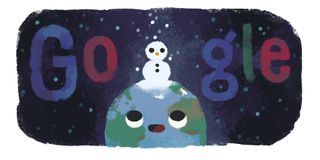Earth celebrated a special occasion on Saturday night (Dec. 21) as the December solstice officially heralds celestial winter in the Northern Hemisphere. Meanwhile, the Southern Hemisphere will mark the beginning of summer. Google celebrated the seasonal milestone with an adorable Google doodle.
The exact moment of solstice occurred at 11:19 p.m. EST (0419 GMT on Dec. 22), according to the Farmer's Almanac. At this point, the sun is directly over the latitude known as the Tropic of Capricorn. This is the furthest south that the sun will ever be over Earth's surface.


Google marked the milestone with an illustration of the Earth with a snowman on top. A second doodle celebrated the start of summer in the Southern Hemisphere.
Up north, the night will be the longest it's been all year, while down south of the equator, people will have experienced their longest day of the year.
Related: December Solstice 2018! Satellites See the Seasons Change from Space
After Saturday's winter solstice, the length of daytime in the north will slowly increase. Then, when it's the northern hemisphere's turn to reach summer solstice in late June, daylight slowly shortens each day and the process begins anew. During the June solstice, the sun is as far north as it can get, sitting straight overhead at the Tropic of Cancer.
The solstices and seasonal changes are caused by the tilt of Earth's axis, which causes the hemispheres to take turns facing the sun throughout the planet's trip around the star.
It's the reason that the poles are as frigid as they are — their extreme latitudes mean that the sun can never be directly overhead.
Follow Doris Elin Urrutia on Twitter @salazar_elin. Follow us on Twitter @Spacedotcom and on Facebook.

"space" - Google News
December 21, 2019 at 10:27PM
https://ift.tt/38XWRtg
Google Doodle Celebrates Last Winter Solstice of the Decade - Space.com
"space" - Google News
https://ift.tt/2Q8TIzF
Shoes Man Tutorial
Pos News Update
Meme Update
Korean Entertainment News
Japan News Update
Bagikan Berita Ini















0 Response to "Google Doodle Celebrates Last Winter Solstice of the Decade - Space.com"
Post a Comment